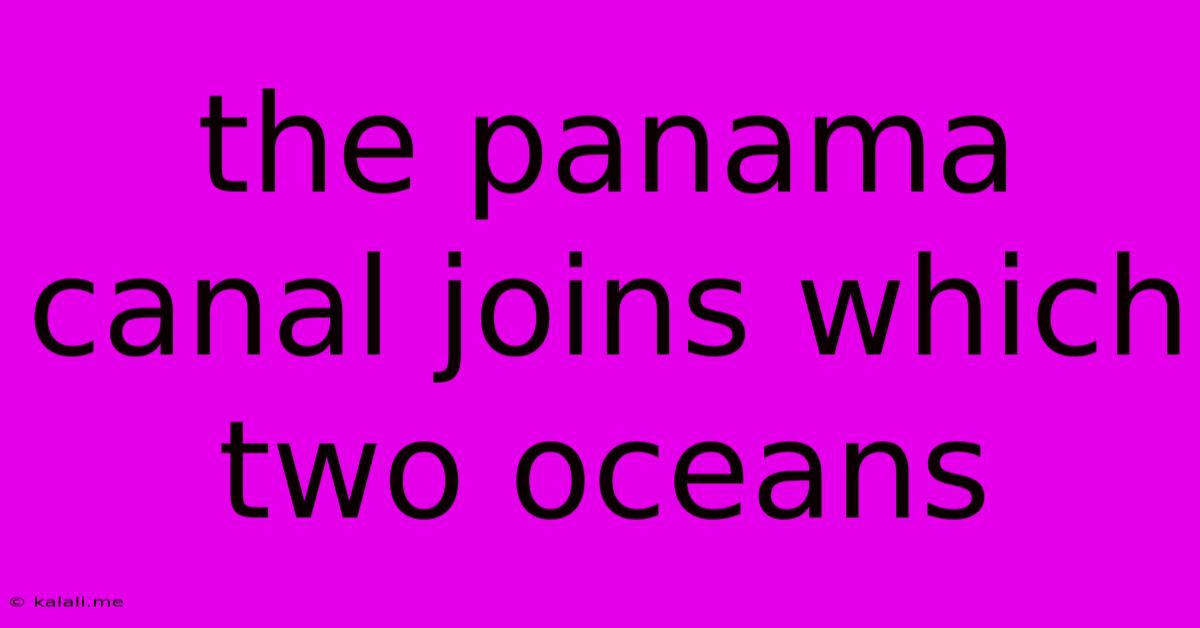The Panama Canal Joins Which Two Oceans
Kalali
Jun 13, 2025 · 2 min read

Table of Contents
The Panama Canal: Joining the Atlantic and Pacific Oceans
The Panama Canal, a marvel of engineering, connects the Atlantic and Pacific Oceans. This feat of human ingenuity significantly reduces travel time and distance for ships navigating between these two massive bodies of water, revolutionizing global trade and maritime transport. Understanding its geographical significance is key to comprehending its impact on world commerce and global connectivity.
This article delves into the specifics of which oceans the Panama Canal links, exploring its historical context, geographical location, and the ongoing impact it has on the world's shipping routes and economies.
A Geographical Divide Bridged
Before the construction of the canal, ships traveling between the Atlantic and Pacific Oceans had to navigate the treacherous and lengthy route around the southern tip of South America, a journey that added thousands of nautical miles and considerable time to their voyages. The Panama Canal dramatically shortened this route, creating a much more efficient and cost-effective passage. It effectively joins the Atlantic Ocean, specifically the Caribbean Sea, with the Pacific Ocean.
More Than Just a Canal: A Strategic Asset
The canal's location is strategically vital. Situated in the narrow Isthmus of Panama, it acts as a crucial gateway connecting two of the world's most significant oceans and maritime trade routes. This strategic position has made the canal a significant geopolitical player throughout history, influencing global power dynamics and trade relationships. The efficient movement of goods through the canal is essential to the global economy, impacting various industries, from agriculture and manufacturing to energy and consumer goods.
The Engineering Marvel and its Impact
The construction of the Panama Canal was a monumental undertaking, a testament to human ingenuity and perseverance. The project presented immense engineering challenges, including the management of the tropical climate, the control of disease, and the excavation of massive amounts of earth. The completion of the canal stands as a significant achievement in engineering and significantly impacted global trade patterns. The reduced travel times and distances resulted in substantial cost savings for shipping companies, making global trade far more efficient.
The Canal's Future and Ongoing Significance
The Panama Canal continues to be upgraded and modernized to accommodate larger vessels and increased traffic. Expansion projects have been undertaken to increase its capacity and further enhance its role in global shipping. Its ongoing significance in facilitating global trade and maritime transport makes it a crucial infrastructure asset for the world economy, connecting not just two oceans but continents and economies across the globe. Its continued operation is vital for maintaining efficient and cost-effective global trade flows. The future of the Panama Canal remains intertwined with the future of global trade and maritime transportation.
In conclusion, the Panama Canal seamlessly links the Atlantic Ocean (specifically the Caribbean Sea) and the Pacific Ocean, revolutionizing global trade and drastically reducing shipping times. Its strategic location and continued importance to the global economy solidify its position as a pivotal piece of global infrastructure.
Latest Posts
Latest Posts
-
Sound And Light Are Both Found As
Jun 14, 2025
-
Difference Between Largest And Smallest Number
Jun 14, 2025
-
Average Sat Score For American University
Jun 14, 2025
-
The Waiter Offered Coupons And Free Food To
Jun 14, 2025
-
Sample Letter Of Closing Bank Account
Jun 14, 2025
Related Post
Thank you for visiting our website which covers about The Panama Canal Joins Which Two Oceans . We hope the information provided has been useful to you. Feel free to contact us if you have any questions or need further assistance. See you next time and don't miss to bookmark.